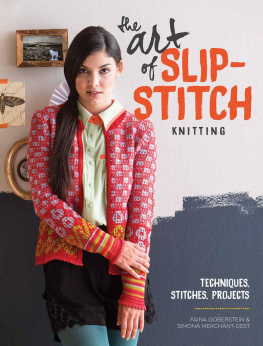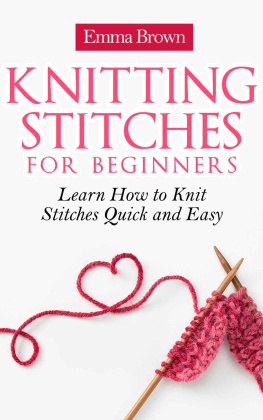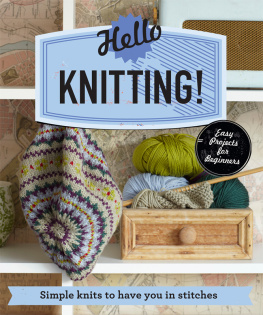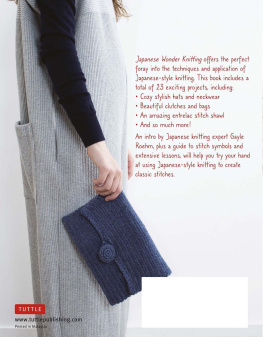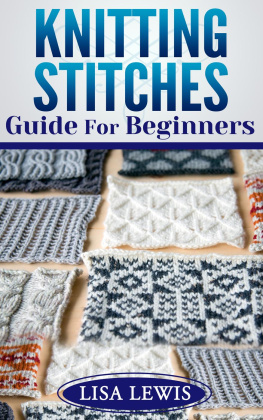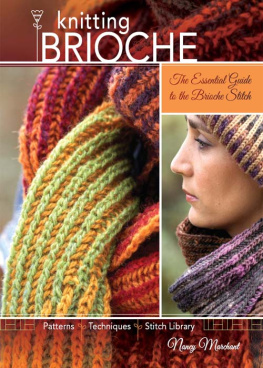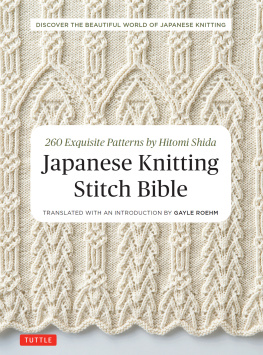Techniques, Stitches, Projects
Faina Goberstein & Simona Merchant-Dest

Dedication
Faina: To Simon, Eli, Rebecca, and Geoff with much love.
Simona: To my daughters, Elika, Marina, and Sofia, you are the force and bottomless pit of inspiration behind everything I do; and to my grandmother who introduced me to the love of knitting.
CONTENTS
Introduction
Working on this book was an interesting and rewarding experience. We both grew up in Europe and saw the use of slip stitch in many folk-knitting projects from different countries, including Estonia, Russia, Czech Republic, Bulgaria, and others. Slip-stitch patterns are often combined with other more popular techniques such as Fair Isle (also known as Jacquard) and textured stitches. As a matter of fact, in Russia, slip stitch is referred to as a Lazy Jacquard, referring to the visual resemblance between multicolored slip stitch and Fair Isle.
As knitters and designers, we are always on the lookout for unique or unusual stitch patterns that produce interesting textures and appearances. Going through stitch dictionaries in search of slip-stitch patterns that are different is often difficult and a disappointment.
The unsuccessful search for distinctly different slip-stitch patterns and our desire to research these types of patterns in depth to give them the attention they deserve developed into more than enough material for this book.
The slip-stitch patterns in this collection are divided into four groups: traditional, woven, fancy, and reversible. Some of these are classic and well known, and some we engineered and developed in the process of doing research for this book.
We begin each chapter with a dictionary of stitches representing that group of slip-stitch patterns. You can choose between written instructions or a chart to knit each stitch pattern.
Weve found that slip-stitch patterns are unpredictable and absolutely fascinating. The more we work, rework, and play with them, the more we find that even with a small change you can make a completely new stitch that has no resemblance to a previous one.
In addition to the forty slip-stitch patterns, there are sixteen stunning, yet easy-to-make projects. Among them are six full garments, two vests, and eight accessories. Each features one or more slip-stitch patterns and demonstrates the possibilities for using these stitches. The stylish and well-fitting projects are made from soft and beautiful yarns that we hope will help change the notion some knitters have that slip stitch creates a bulky fabric. Not anymore! When worked with thoughtfully chosen modern yarns paired with correct needle sizes, slip-stitch fabric can be lacy, as you can see in the .
Project Names
For the projects in this book, we chose Czech and Russian (our native languages) names that describe our inspiration for the design, color, construction elements, or other aspects of the designs. See the sidebar on for the translations and pronunciations.
It is our hope that you will catch on to our excitement over this fresh look at this family of stitches. Follow our lead and experiment with fibers, colors, textures, and needle sizes while working the same patterns we present to you. If you are like us and love adventure, you will come up with almost countless variations of these stitches.
We are very excited to share with you our findings of what slip stitch can do: its beauty, its endless possibilities, and the great versatility it offers. Were looking forward to seeing your variations of the slip-stitch patterns in your projects.
Chapter 1
All About Slip-Stitch Knitting
Sometimes after knitting a row we notice that weve made a mistake; one or more stitches do not have a yarn pulled through them. Rather, the yarn is floating between the flanking stitches on the back of the work, and the skipped stitches are taller than the others. Its probably safe to say that in the early days of knitting, this mistake drew the attention of some curious knitters. They began experimenting with this effect to obtain interesting patterns just by skipping some stitches in an orderly fashion.
The evidence of slip-stitch patterns can be traced to the early days of knitting in various parts of the world, but most of the time it was not isolated as a separate and distinct technique. Because the earliest written knitting instructions known to us date to the nineteenth century, and not all techniques were popular and developed at the same time, its hard to say when and where the slip-stitch technique, as we now know it, originated. There is evidence of slipped stitches used in decreases as early as the nineteenth century.
Although the focus of this book is on exploring slip-stitch technique and its usage, lets first take a closer look at the slipped stitch itself and how its used.
A stitch can be slipped with the yarn held in front or back. We choose one or the other depending on the effect we want to achieve. We can then work slipped elongated stitches into a pattern as knit, purl, or tuck stitches. They can also be used to form cables or traveling stitches, horizontal chains, herringbone patterns, and much more.
The Formation of Slip Stitch
In certain patterns and techniques, a stitch is intentionally slipped with no yarn looped through it. In order for us to work the next stitch, we strand the yarn either in the back or front of the stitch, or sometimes over the needle.

